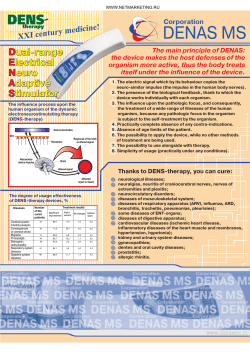
Solutions of Exercises.
Signals and Systems Solutions to Homework Assignment #5 Problem 1. O&W7.29 4 1/T = 20kHz, so ωs = 2π/T = 4π × 10 rad/s. We are given Xc(jω): jω Xp(jω) has copies of X(e ) at every multiple of ωs and scaled down by T: jω X(e ) is Xp(jω) with the frequency renormalized so that Ω = ωT: jω The DT filter keeps only the frequencies ω such that |ω| < π/4, so Y(e ) is: 1 We can now run the CT-to-DT process in reverse to arrive at Yp(jω)and Y(jω): Problem 2. O&W 7.31 It is given that X(jω) = 0 for |ω| ≥ π/T and we have a sampling frequency, ωs = 2π/T, so there will be no aliasing. x[n] is the sampled xc(t) with no loss and the amplitude of a particular x[n]is the area of the corresponding impulse. jΩ jΩ X(jω) is sampled and becomes X(e ) and then is multiplied by Hd(e ). After interpolation, jωT Yc(jω) = Xc(jω)Hd(e ). The difference equation for h[n] is given as y[n] = ½y[n −1] + x[n], which gives: jω −jΩ jΩ jΩ Y(e ) = ½e Y(e ) + X(e ). The discrete-time frequency response is: 2 Since all of the sampling and interpolation works out, the continuous-time frequency response is: Problem 3. O&W 7.35 (a) xp[n] is just x[n] sampled at every other point as sketched below: xd[n] is x[n] downsampled by 2, and therefore it has all the stems in xp[n], except that all the zero points between samples are gone (i.e. xd[n] is xp[n] time-scaled by 1/2). xd[n] is sketched below: (b) jω jω Since xp[n] is x[n] sampled by a DT impulse train of period 2, Xp(e ) is X(e ) jω periodically convolved with an impulse train of period π. Therefore, Xp(e ) will have the jω triangular spectrum replicated at integer multiples of π, with height scaled by ½. Xp(e ) is graphed below: jω jω/2 Since xd[n] = xp[2n], Xd(e ) = Xp(e 3 jω ). Xd(e ) is graphed below: Problem 4. O&W 7.38 Let the frequency of the cosine be ω0 = 2π/T and the sampling frequency be ωs = 2π/(T+Δ). Then, the Fourier transform of x(t) = A + Bcos(ω0t + θ) is jθ −jθ X(jω) = 2πAδ(ω) + πB(e δ(ω −ω0) + e δ(ω+ ω0)) In order for y(t) to be proportional to x(at), we need So, the Fourier transform Y(jω) of y(t) must be proportional to Note that the “B” impulses in Y(jω) are closer to the “A” impulse than they are in X(jω). The Fourier transform Xp(jω) of xp(t) = x(t)p(t) is X(jω) convolved with a train of impulses located at integer multiples of ωs. Thus the rightmost “B” impulse in X(jω) contributes impulses in Xp(jω) at all frequencies ω0 − nωs, where n is an integer. In order to get the desired Y(jω) (shown above), exactly one of the frequencies ω0 − nωs must be in the interval 0 < ω < ωs/2, 4 where ωs/2 represents the cutoff frequency of the low-pass filter. Thus, 0 < ω0 − nωs < ωs/2 Solving for constraints on ωs yields In order for the shifted frequency to be smaller than ω0, n must be greater than zero. These ranges are indicated in the following table. The factor a is the ratio of the frequencies “B” impulses in Y(jω)and in X(jω), i.e., Problem 5. O&W 7.42 We want to use Parseval’s relation for this problem: Since the continuous-time signal is sampled beyond Nyquist rate, we don’t have to worry about aliasing. Over the period −π < Ω ≤ π, therefore, we can say that Now, compute the energy in the sampled signal using the equations above: 5 Problem 6. O&W 7.45 (a) We have a band-limited signal, the Nyquist frequency 4 ωN = 2ωM = 2×2π × 10 and we should sample at 2π/T > ωN. Therefore, (b) The impulse response would be hn[n] = Tu[n]. (c) We first look at what would look like. Then we simplify limn→∞ y[n]. jω As we know already, X(e ) = (1/T)X(jΩ/T) if there is no aliasing at any particular Ω. j0 For to be true, TX(e ) = Xc(j0) has to be true, i.e., there can be no aliasing at ω = 0. We do not mind aliasing as long as Xp(j0) = Xc(j0). Suppose Xc(jω) is a triangular waveform with band-limit frequency ωM. 6 Xc(jω) Xp(jω) where ωs = 2π/T. Thus, we do not want the copies at kω0 for non-zero k values to overlap with the copy at 0. want ωs − ωM > 0, i.e., ωs > ωM. Therefore, T < 2π/ωM, Tmax = −4 10 s. Problem 7. O&W 7.46 Note that the filter should have gain N and cutoff frequency ωc = π/N. The system is given by the figure below: Assume that the frequency response of x[n] is given in figure (a) below, and the frequency response of the sampling sequence p[n] is given as in figure (b). If ωs > 2ωm, then there is no jω aliasing (i.e the non-zero replicas of X(e ) do not overlap), as shown in figure (c), whereas if ωs < 2ωm, then over lapping occurs and aliasing results, as shown in figure (d). In the absence jω of aliasing, X(e ) is faithfully reproduced around ω = 0 and integer multiples of 2π. Hence x[n] can be completely recovered from xr[n]. In the case of aliasing, xr[n] will no longer be equal to x[n]. However, the two sequences will be equal at multiples of the sampling period. This is shown in (d) by the dotted lines at multiple values of ωs, the values occuring at these jω locations are the same as that in Xp(e ). Hence, xr[mN] = x[mN] regardless of aliasing. 7 8
© Copyright 2025

![[ ] sin [ ] - Oregon State University](http://cdn1.abcdocz.com/store/data/000701149_1-0bf1cae8507d705aa8597319f112cba3-250x500.png)








